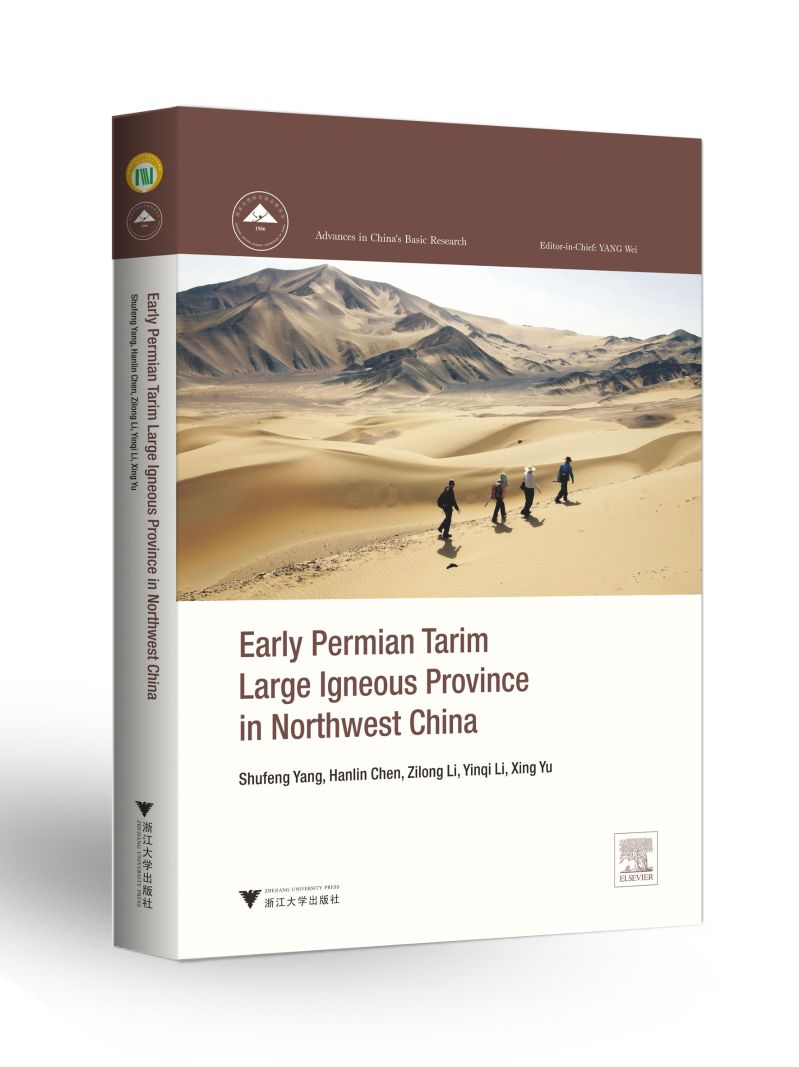Early Permian Tarim Large Igneous Province in Northwest China
(《塔里木早二叠世大火成岩省》)

丛书简介
“中国基础研究前沿”系列丛书由国家自然科学基金委员会策划出版,以“科学、基础、前沿”为定位,以“共享基础研究创新成果,传播科学基金资助绩效,引领关键领域前沿突破”为宗旨。该丛书由基金委第七届主任杨卫院士担任主编并作序,具体工作由基金委科学传播中心(科学基金杂志社)组织实施。
内容简介
Early Permian Tarim Large Igneous Province in Northwest China(《塔里木早二叠世大火成岩省》)是国内外首部系统介绍塔里木大火成岩省的英文专著,是以“塔里木早二叠世大火成岩省形成的深部地质过程与大陆动力学”为主的多项国家自然科学基金项目和国家重点基础研究发展计划(973)的研究成果总结。本书详细阐述了塔里木大火成岩省的时空分布特征、塔里木大火成岩省内部各岩石单元的岩石地球化学特征和岩浆演化,以及塔里木大火成岩省的地球动力学和成矿作用;提出一个完全不同于既有大火成岩省形成的德干模型和巴哈那模型的新的大火成岩省形成模型。
作者简介
杨树锋,中国科学院院士,浙江大学地球科学学院教授、博士生导师,曾任浙江大学研究生院常务副院长。我国培养的第一个地质学博士。主要从事板块构造与花岗岩成因理论、板内岩浆作用与地球动力学和冲断带变形理论等方面的研究。
各章摘要
Chapter 1: Introduction
Abstract: This chapter includes the tectonic evolution of the Tarim Block, a brief introduction to Large Igneous Provinces (LIPs) and a history of the research on the Early Permian Tarim Large Igneous Province (Tarim LIP). The first part introduces the evolution of the basement during the tectonic episodes at 2.65‒2.45 Ga, 2.0‒1.8 Ga and 1.1‒0.9 Ga, and the evolution of sedimentary cover sequences since the Late Neoproterozoic and igneous activity. The second part introduces the concept of LIPs, their classification, the age spectrum of selected LIP events through time and the effect of LIPs on the evolution of the Earth, environmental change and ore deposits, etc. The third part introduces a history of research on and the basic characteristics of the Tarim LIP.
Keywords: Tectonic evolution; History of research; Early Permian Tarim Large Igneous Province (Tarim LIP); Tarim Block
Chapter 2: Tempo-Spatial Features of the Tarim LIP
Abstract: The study of the tempo-spatial features of the Tarim Large Igneous Province (Tarim LIP) can provide some good evidence of the limits of one of the world’s Large Igneous Provinces (LIPs). The results of some recent research on the tempo-spatial features of the Tarim LIP will be addressed in this study. Through the systematical and detailed study of the spatial distribution and the precise dating and contact relationships between the main rock units in the Tarim LIP and the host rocks, the distribution of the Tarim LIP reaches over 2.5×105 km2, which is a Permian LIP in NW China. The temporal order of the Tarim LIP can be considered continental flood basaltic lavas in the Kupukuziman and Kaipaizileike formations (292–285 Ma) in the early stage, and layered mafic ultramafic complex, very rich magnesium ultramafic dike, mica-olivine pyroxenite breccia pipe, diabase dike, quartz syenite and bimodal dike (284–274 Ma) in the late stage.
Keywords: Temporal order; Spatial distribution; Field contact relationship; Chronology; Tarim Large Igneous Province (Tarim LIP)
Chapter 3: Geochemical Features of the Tarim LIP Rocks and Implications for the Magma Evolution
Abstract: The various igneous rocks in the Tarim LIP can be divided into 5 major units according to their geochemical and isotopic characteristics, including 3 earlier erupted basalt groups and 2 later emplaced intrusive rock units. There is an evolutional trend of the Sr–Nd–Hf isotopes from enriched mantle components in the earlier basalts towards depleted mantle components in the later intrusive rocks. The 3 basalt groups in the Tarim LIP have experienced variable degrees of crustal contamination, whereas the intrusive rocks are generally not contaminated. After removing the interference of crustal contamination, the uncontaminated parental magmas of various Tarim LIP rocks exhibit a wide range of εNd(t) values (ca. –5 to 5), reflecting source isotopic heterogeneity, which may be a consequence of plume–lithosphere interaction during the generation of the Tarim LIP.
Keywords: Geochemical features; Sr–Nd–Hf isotopes; Crustal contamination; Magma evolution; Three basalt groups
Chapter 4: Geodynamics of the Tarim LIP
Abstract: The Tarim Large Igneous Province (Tarim LIP) agrees well with the mantle plume model in terms of its tempo-spatial distribution of Permian igneous rocks. The domal uplift of the crust before eruption, widespread dike swarms and occurrence of picrate also support the plume involvement in the origin of the Tarim LIP. The inter-relationship between the Tarim LIP and adjacent Permian magmatisms, like the Tianshan Group, the Emeishan LIP and Siberian Traps, indicates that the Tarim LIP is geologically independent from these igneous provinces. The geochemical signatures and tempo-spatial distribution of the Tarim LIP appeals to a two-stage melting model for Permian Tarim magmatism. The geodynamic settings of the Tarim Block in the Early Permian lead to the plume-lithosphere interaction for the petrogenesis of the Tarim LIP.
Keywords: Domal uplift; Dike swarm; Geochemical comparison; Mantle plume; Geodynamic model; Tarim Large Igneous Province (Tarim LIP)
Chapter 5: Metallogenesis of the Tarim LIP
Abstract: The Wajilitag Fe–Ti–V oxide deposit is the only ore body that is being mined in the Tarim LIP. It was probably formed by a slowly cooling magmatic crystallization from a deep magma chamber. Fe–Ti oxides therein were formed by two stages of fractionations: minor Fe–Ti oxides as oxide inclusions in the silicate minerals were crystallized in the early stage of the magmatic process, whereas most of the Fe–Ti oxides were accumulated interstitial to the silicate minerals in the late stage of the magmatic process when silicate crystals had already cumulated. The parental magma of the Wajilitag intrusion was enriched in Fe and Ti, which may be produced by a low degree of partial melting from the mantle source. Extensively fractional crystallization may have caused the evolved magma with a further Fe–Ti enrichment.
The PGE (Platinum-group elements) geochemistry study reveals that the Tarim CFBs are extremely depleted in PGE concentrations, which is mainly due to the very low degrees (<5%) of partial melting in the mantle source. The degree of partial melting plays an important role in the Cu–Ni–PGE mineralization in the Tarim LIP, thus mafic–ultramafic rocks formed by high-degree partial melting from the mantle source in the Tarim LIP should receive more attention in terms of their Cu–Ni–PGE mineralization potential. Besides, the PGE study on the Keping basalts indicates that magma replenishment in the magma chamber may once again trigger S-saturation and saturated sulfide segregation in the evolved magma, which may make it possible to develop a Cu–Ni–PGE sulfide deposit in the Keping area.
Keywords: Wajilitag; Fe–Ti–V oxide deposit; PGE; Metallogenesis

